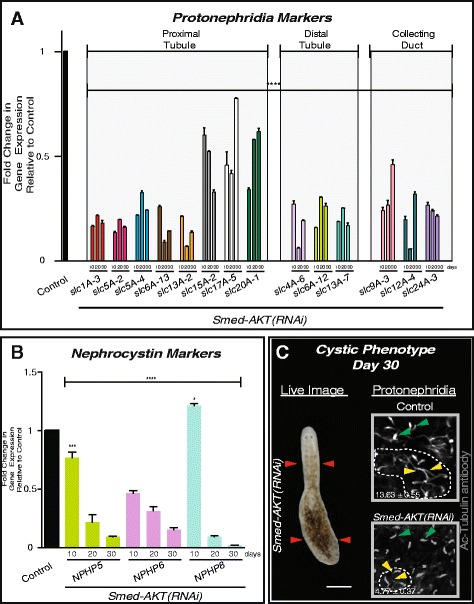Fig. 5.

Down-regulation of Akt leads to a delayed onset of a cystic phenotype. a Levels of expression of solute carrier (slc) genes expressed along the planarian protonephridia tubules (proximal and distal) and collecting ducts. There is a striking reduction in expression of all slc genes evident as early as day 10 and is sustained through day 30 after Smed-AKT(RNAi). Each individual sample was analyzed relative to its individual control. b Expression levels of nephrocystin markers (NPHP5, 6 and 8) at different time points after RNAi. Levels of expression for each gene are relative to individual controls. All NPHP genes showed markedly reduction in gene expression across 30 days after the first dsRNA injection. In all cases, gene expressions are relative to the internal control, the ubiquitously expressed clone H.55.12e. Graphs represent mean ± s.e.m. of triplicated samples of two biological replicates consisting of at least ten animals per experiment. Significance **** <0.0001 is determined through two way-ANOVA. c Cystic phenotype is seen in Smed-AKT(RNAi) animals by day ≥30 after first dsRNA injection (N = 30/30). In the live image, seen on the left, the features of a cystic phenotype (elongation of the head and bloating of the tail) are highlighted by red arrows. Confocal z-stack images on the right, control (top) and Smed-AKT(RNAi) (bottom), highlight protonephridial clusters (dotted lines)using Ac-Tubulin staining in the posterior ventral surface at day 30. Protonephridial clusters contain tubules (yellow arrows) and flame cells (green arrows). The number of flame cells per proximal unit are strongly reduced (**** P < 0.0001, student t-test) in Smed-AKT(RNAi) animals 4.77 ± 0.72 vs 13.63 ± 0.55 in control. Flame cell counts were obtained from 5 or more animals, totaling N=30 or more clusters analyzed per condition
